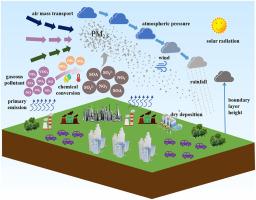随机森林与可解释方法耦合模型量化了 PM2.5 与影响因素之间的响应关系
IF 4.2
2区 环境科学与生态学
Q2 ENVIRONMENTAL SCIENCES
引用次数: 0
摘要
环境细颗粒物(PM2.5)受多种因素的影响,如污染源排放、气象条件和化学反应。揭示这些因素对 PM2.5 的影响对于了解 PM2.5 污染的成因至关重要。机器学习方法可以建立影响因素与 PM2.5 之间的非线性关系。本文构建了机器学习与解释方法的耦合模型,从多个维度全面量化影响因素对PM2.5的重要性,分析影响因素的敏感性。在影响因素一级指标中,排放、气象条件和大气化学反应对PM2.5的重要程度分别为49%、29%和22%。在影响因素的二级指标中,传输效应是最重要的气象条件,其重要程度为 15%。液相反应是最重要的大气化学反应,重要程度为 7%。在三个层次的影响因素中,排放、传输距离、液相反应系数、气溶胶酸度和积聚促进系数是重要因素。单个因素的敏感性复杂多变,排放与其他重要因素的交互作用是两个因素中最强的。其中,观测期内传输距离与排放量的交互作用最强,交互作用系数为 1.82。我们的研究重点关注影响因素对PM2.5的影响,为PM2.5污染成因分析提供依据,为PM2.5治理提供技术支持。本文章由计算机程序翻译,如有差异,请以英文原文为准。

The coupling model of random forest and interpretable method quantifies the response relationship between PM2.5 and influencing factors
Ambient fine particulate matter (PM2.5) is affected by many factors, such as source emissions, meteorological conditions, and chemical reactions. Revealing the effects of these factors on PM2.5 is essential to understand the causes of PM2.5 pollution. The machine learning method can establish the non-linear relationship between influencing factors and PM2.5. Here, a coupling model of machine learning and interpretation method was constructed to comprehensively quantify the importance of influencing factors to PM2.5 from multiple dimensions and analyze the sensitivity of influencing factors. Among the primary indicators of influencing factors, the importance of emission, meteorological conditions, and atmospheric chemical reaction to PM2.5 is 49%, 29%, and 22%, respectively. In the secondary indicator of influencing factors, the transmission effect is the most important meteorological condition, with an important degree of 15%. The liquid phase reaction is the most important atmospheric chemical reaction, with an importance of 7%. Among the three levels of influencing factors, emission, transport distance, liquid phase reaction coefficient, aerosol acidity, and accumulation promotion coefficient are important factors. The sensitivity of a single factor is complex and changeable, and the interaction between emission and other important factors is the strongest among the two factors. Of which the interaction between transmission distance and emission during the observation period is the strongest, and the interaction coefficient is 1.82. Our study focuses on the effect of influencing factors on PM2.5, provides a basis for the analysis of the causes of PM2.5 pollution, and technical support for the treatment of PM2.5.
求助全文
通过发布文献求助,成功后即可免费获取论文全文。
去求助
来源期刊

Atmospheric Environment
环境科学-环境科学
CiteScore
9.40
自引率
8.00%
发文量
458
审稿时长
53 days
期刊介绍:
Atmospheric Environment has an open access mirror journal Atmospheric Environment: X, sharing the same aims and scope, editorial team, submission system and rigorous peer review.
Atmospheric Environment is the international journal for scientists in different disciplines related to atmospheric composition and its impacts. The journal publishes scientific articles with atmospheric relevance of emissions and depositions of gaseous and particulate compounds, chemical processes and physical effects in the atmosphere, as well as impacts of the changing atmospheric composition on human health, air quality, climate change, and ecosystems.
 求助内容:
求助内容: 应助结果提醒方式:
应助结果提醒方式:


